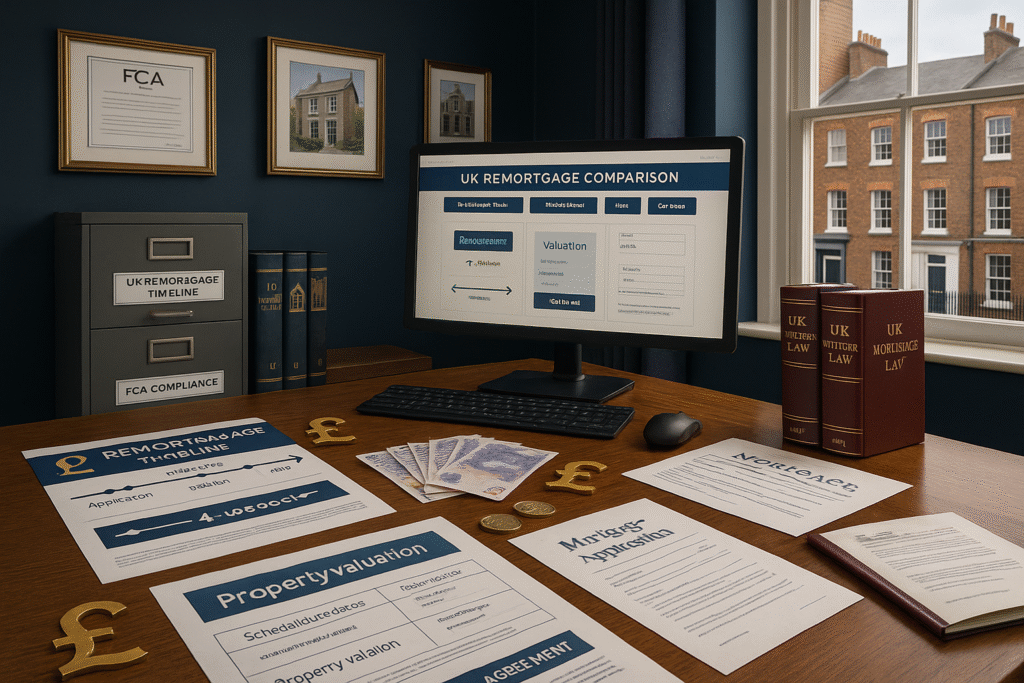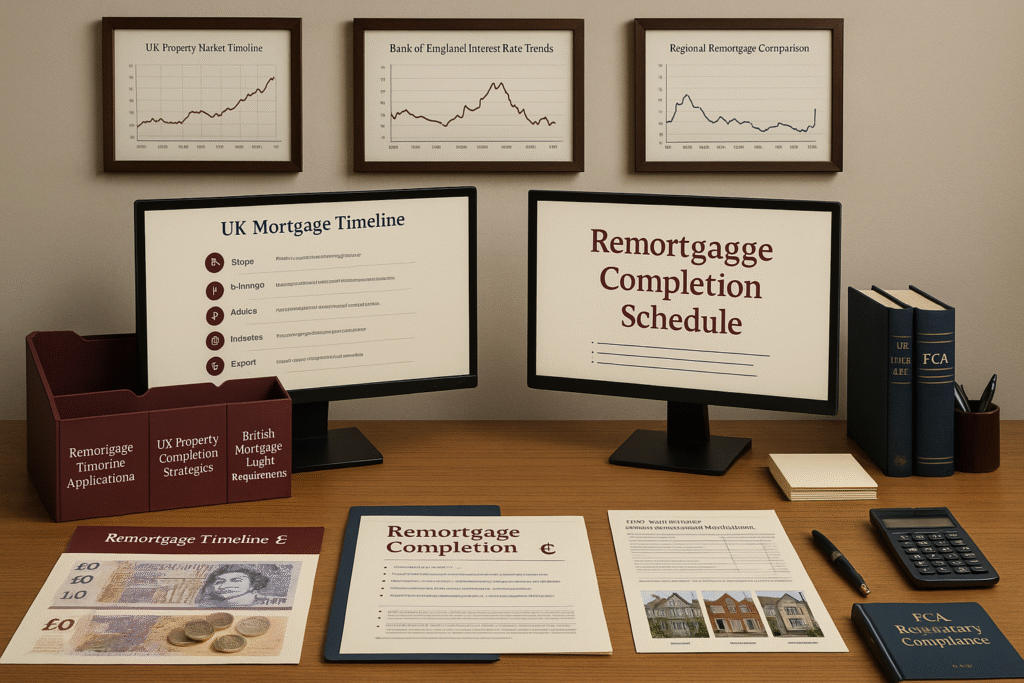A UK remortgage typically takes between 4 to 8 weeks from initial application to completion, though this timeframe can vary significantly depending on your circumstances, chosen lender, and the complexity of your financial situation. Understanding the remortgaging process and its various stages helps homeowners plan effectively and avoid unnecessary delays that could impact their financial arrangements.
The remortgaging timeline encompasses several distinct phases including initial research and application, property valuation, underwriting assessment, mortgage offer, and legal completion. Each stage involves specific requirements and potential delays that can extend the overall process, making it essential to understand what factors influence timing and how to prepare accordingly.
Understanding UK Remortgaging Process
This is essentially how Remortgaging works: Remortgaging involves replacing your existing mortgage with a new mortgage deal, either with your current lender or a different lender entirely. This process allows homeowners to take advantage of better interest rates, release equity from their property, or modify their mortgage terms to better suit their current financial circumstances.

The UK remortgaging market operates under Financial Conduct Authority regulations, ensuring that lenders conduct thorough affordability assessments and provide appropriate consumer protections. These regulatory requirements contribute to the overall timeline, as lenders must complete comprehensive checks and documentation before approving new mortgage arrangements.
Most UK homeowners consider remortgaging when their current fixed-rate or discount period ends, as reverting to the lender’s standard variable rate often results in significantly higher monthly payments. The remortgaging process provides an opportunity to secure more competitive rates and potentially save thousands of pounds over the mortgage term.
Detailed Remortgage Timeline Breakdown
The initial application phase typically takes 1 to 2 weeks, during which you research available mortgage products, gather required documentation, and submit your formal application. This stage involves comparing interest rates, mortgage terms, and fees across different lenders to identify the most suitable product for your circumstances.
Property valuation usually occurs within 1 to 2 weeks of application submission, with most lenders arranging automated valuations or desktop assessments for straightforward cases. More complex properties may require physical surveys, which can extend this timeframe and potentially delay the overall process if valuation issues arise.
The underwriting and assessment phase generally takes 2 to 3 weeks, during which lenders review your financial circumstances, verify income and employment details, and conduct credit checks. This stage often represents the longest part of the remortgaging process, as underwriters must thoroughly assess all aspects of your application against their lending criteria.
Mortgage offer issuance typically occurs within 1 week of successful underwriting completion, providing formal confirmation of the lender’s willingness to provide the new mortgage on specified terms. The offer remains valid for a limited period, usually 3 to 6 months, during which you must complete the legal transfer process.
Legal completion can take 2 to 4 weeks, involving solicitor or conveyancer services to handle the legal transfer of the mortgage from your existing lender to the new lender. This stage includes conducting local authority searches, reviewing mortgage terms, and coordinating the financial settlement between all parties.

Factors Affecting Remortgage Duration
Your credit history significantly impacts the remortgaging timeline, as lenders require more detailed assessment for applicants with adverse credit records. Complex credit situations may require additional documentation, specialist lender consideration, or manual underwriting processes that extend the overall timeframe.
Employment circumstances influence processing speed, with employed applicants typically experiencing faster assessments than self-employed borrowers. Self-employed applicants usually require additional documentation including business accounts, tax returns, and accountant certifications, which can add several weeks to the process.
Property characteristics affect valuation requirements and potential complications, with unusual property types, leasehold arrangements, or properties in declining areas potentially requiring more detailed assessment. Listed buildings, ex-local authority properties, or those with structural issues may face additional scrutiny that delays completion.
The chosen lender’s efficiency varies considerably across the UK mortgage market, with some lenders processing applications significantly faster than others. Specialist lenders often take longer than mainstream providers, whilst some challenger banks have streamlined processes that can reduce overall timescales.
Switching between lenders typically takes longer than remortgaging with your existing lender, as new lenders must conduct fresh assessments and valuations. However, staying with your current lender may limit your access to the most competitive rates available in the broader market.
Preparing for Efficient Remortgaging
Document preparation significantly impacts the speed of your remortgage application, with well-organised applicants typically experiencing faster processing times. Essential documents include recent payslips, bank statements, tax returns for self-employed applicants, proof of identity, and details of existing mortgage arrangements.
Credit score improvement before applying can enhance both the range of available products and the speed of assessment, as lenders process applications from borrowers with excellent credit histories more quickly. Checking your credit report for errors and addressing any issues before application submission helps avoid delays during underwriting.
Professional advice from qualified mortgage brokers can streamline the process by identifying suitable lenders, preparing applications correctly, and managing communication throughout the timeline. Experienced brokers understand different lenders’ requirements and can help avoid common pitfalls that cause delays.
Early planning allows sufficient time for the complete remortgaging process without rushing important decisions or compromising on terms. Starting the process 3 to 4 months before your current deal expires provides adequate time for research, application, and completion whilst maintaining negotiating flexibility.

Choosing Between Current and New Lenders
Remortgaging with your existing lender often provides faster processing times, as they already hold your financial information and property details. This approach can reduce the timeline to 2 to 4 weeks in straightforward cases, avoiding the need for fresh valuations and extensive documentation. Choosing the Remortgage Process with the Same Lender can be an efficient option for homeowners seeking minimal disruption.
However, staying with your current lender may limit access to the most competitive rates available in the broader market. Product transfer arrangements with existing lenders sometimes offer convenience at the expense of potential savings that could be achieved through switching to a new provider.
Switching to a new lender typically provides access to a wider range of mortgage products and potentially better terms, but requires a complete application process including fresh valuations and underwriting. This approach generally takes the full 4 to 8 weeks but may result in significant long-term savings.
The decision between current and new lenders should consider both the potential financial benefits and the time constraints of your situation. If your current deal is ending soon, the faster timeline of staying with your existing lender might outweigh the potential benefits of switching, whilst those with more time can explore the full market.
Managing Potential Delays
Common delays in the remortgaging process include incomplete documentation, property valuation issues, employment verification problems, and legal complications. Understanding these potential obstacles allows proactive management and mitigation strategies that can maintain your planned timeline.
Communication with all parties throughout the process helps identify and resolve issues quickly, preventing minor problems from becoming major delays. Regular contact with your mortgage broker, lender, and solicitor ensures that any requirements or concerns are addressed promptly.
Contingency planning for potential delays includes maintaining flexibility in your completion date and ensuring that backup arrangements are in place if your current mortgage deal expires before the new arrangement completes. Some lenders offer rate guarantees or extension options that can provide additional security during the transition period.
Professional support from experienced mortgage advisers and solicitors can help navigate complex situations and resolve issues that might otherwise cause significant delays. Their expertise in handling remortgage transactions often proves invaluable in maintaining progress towards completion.




